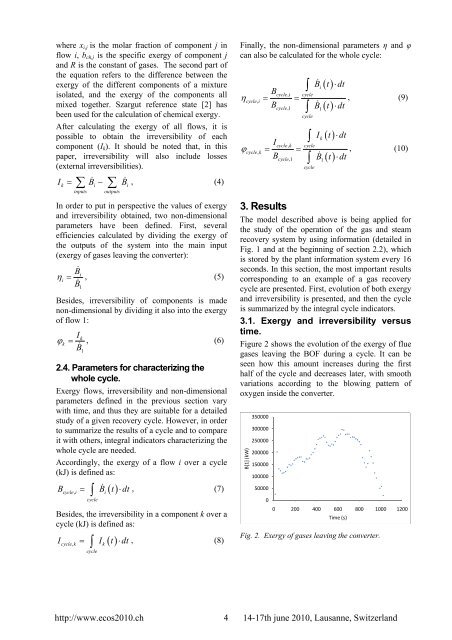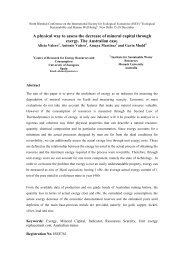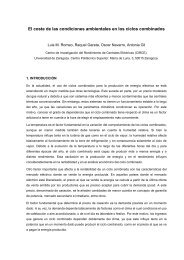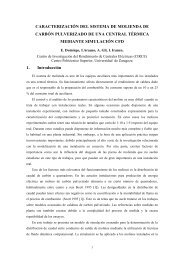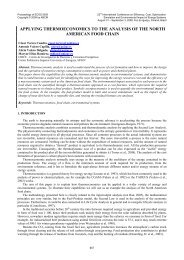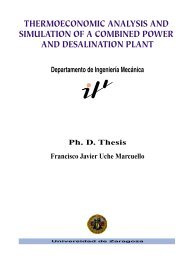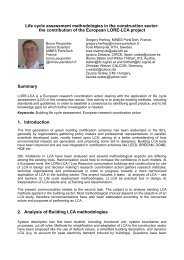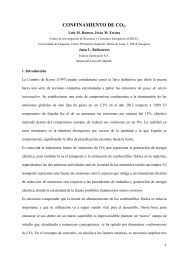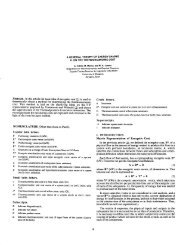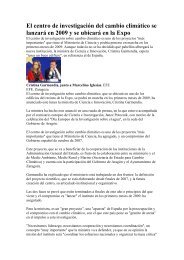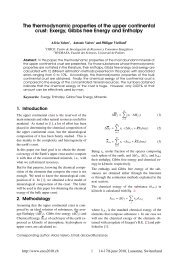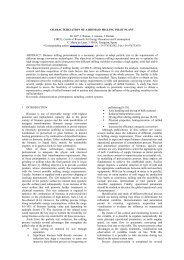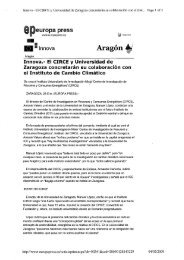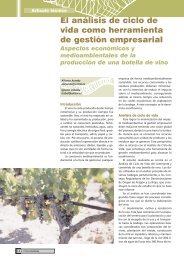Engineering Application of Exergy Analysis - circe - Universidad de ...
Engineering Application of Exergy Analysis - circe - Universidad de ...
Engineering Application of Exergy Analysis - circe - Universidad de ...
Create successful ePaper yourself
Turn your PDF publications into a flip-book with our unique Google optimized e-Paper software.
where xi,j is the molar fraction <strong>of</strong> component j in<br />
flow i, bch,j is the specific exergy <strong>of</strong> component j<br />
and R is the constant <strong>of</strong> gases. The second part <strong>of</strong><br />
the equation refers to the difference between the<br />
exergy <strong>of</strong> the different components <strong>of</strong> a mixture<br />
isolated, and the exergy <strong>of</strong> the components all<br />
mixed together. Szargut reference state [2] has<br />
been used for the calculation <strong>of</strong> chemical exergy.<br />
After calculating the exergy <strong>of</strong> all flows, it is<br />
possible to obtain the irreversibility <strong>of</strong> each<br />
component (Ik). It should be noted that, in this<br />
paper, irreversibility will also inclu<strong>de</strong> losses<br />
(external irreversibilities).<br />
I = B − B<br />
, (4)<br />
∑ ∑<br />
k i i<br />
inputs outputs<br />
In or<strong>de</strong>r to put in perspective the values <strong>of</strong> exergy<br />
and irreversibility obtained, two non-dimensional<br />
parameters have been <strong>de</strong>fined. First, several<br />
efficiencies calculated by dividing the exergy <strong>of</strong><br />
the outputs <strong>of</strong> the system into the main input<br />
(exergy <strong>of</strong> gases leaving the converter):<br />
Bi<br />
η i =<br />
B<br />
<br />
, (5)<br />
<br />
1<br />
Besi<strong>de</strong>s, irreversibility <strong>of</strong> components is ma<strong>de</strong><br />
non-dimensional by dividing it also into the exergy<br />
<strong>of</strong> flow 1:<br />
I<br />
k ϕ k = , (6)<br />
B<br />
1<br />
2.4. Parameters for characterizing the<br />
whole cycle.<br />
<strong>Exergy</strong> flows, irreversibility and non-dimensional<br />
parameters <strong>de</strong>fined in the previous section vary<br />
with time, and thus they are suitable for a <strong>de</strong>tailed<br />
study <strong>of</strong> a given recovery cycle. However, in or<strong>de</strong>r<br />
to summarize the results <strong>of</strong> a cycle and to compare<br />
it with others, integral indicators characterizing the<br />
whole cycle are nee<strong>de</strong>d.<br />
Accordingly, the exergy <strong>of</strong> a flow i over a cycle<br />
(kJ) is <strong>de</strong>fined as:<br />
Bcycle, i = ∫ Bi() t ⋅dt<br />
, (7)<br />
cycle<br />
Besi<strong>de</strong>s, the irreversibility in a component k over a<br />
cycle (kJ) is <strong>de</strong>fined as:<br />
Icycle, k = ∫ Ik() t ⋅dt<br />
, (8)<br />
cycle<br />
Finally, the non-dimensional parameters η and φ<br />
can also be calculated for the whole cycle:<br />
η<br />
ϕ<br />
cycle, i<br />
cycle, k<br />
cycle,1<br />
1<br />
cycle<br />
()<br />
B i t dt<br />
B ∫ ⋅<br />
cycle, i cycle<br />
= =<br />
, (9)<br />
B B t ⋅ dt<br />
∫<br />
∫<br />
cycle,1<br />
1<br />
cycle<br />
()<br />
()<br />
Ik t ⋅ dt<br />
Icycle,<br />
k cycle<br />
= =<br />
, (10)<br />
B B t ⋅ dt<br />
3. Results<br />
∫ <br />
()<br />
The mo<strong>de</strong>l <strong>de</strong>scribed above is being applied for<br />
the study <strong>of</strong> the operation <strong>of</strong> the gas and steam<br />
recovery system by using information (<strong>de</strong>tailed in<br />
Fig. 1 and at the beginning <strong>of</strong> section 2.2), which<br />
is stored by the plant information system every 16<br />
seconds. In this section, the most important results<br />
corresponding to an example <strong>of</strong> a gas recovery<br />
cycle are presented. First, evolution <strong>of</strong> both exergy<br />
and irreversibility is presented, and then the cycle<br />
is summarized by the integral cycle indicators.<br />
3.1. <strong>Exergy</strong> and irreversibility versus<br />
time.<br />
Figure 2 shows the evolution <strong>of</strong> the exergy <strong>of</strong> flue<br />
gases leaving the BOF during a cycle. It can be<br />
seen how this amount increases during the first<br />
half <strong>of</strong> the cycle and <strong>de</strong>creases later, with smooth<br />
variations according to the blowing pattern <strong>of</strong><br />
oxygen insi<strong>de</strong> the converter.<br />
B[1] (kW)<br />
350000<br />
300000<br />
250000<br />
200000<br />
150000<br />
100000<br />
50000<br />
0<br />
0 200 400 600 800 1000 1200<br />
Time (s)<br />
Fig. 2. <strong>Exergy</strong> <strong>of</strong> gases leaving the converter.<br />
http://www.ecos2010.ch 4 14-17th june 2010, Lausanne, Switzerland


